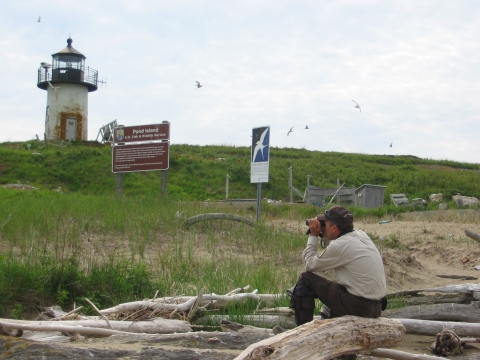Visit Us
Because the refuge lands and islands are scattered along the whole Maine coast, the refuge has two offices. One is located in Milbridge, Maine, approximately 35 miles east of Ellsworth. The other office is located in Rockland, heading toward Owls Head. Office hours are Monday - Friday, 8:00 a.m. - 4:30 p.m. Printed materials are available at both offices 24 hours a day.
The mainland divisions are located in Milbridge, Steuben, Corea and Gouldsboro. There are opportunities for bird watching, wildlife photography, and hiking on the Petit Manan Point Division, in Steuben as well as trails in Corea and Gouldsboro.
Location and Contact Information
About Us
The Maine Coastal Islands National Wildlife Refuge contains more than 76 offshore islands and four coastal parcels, totaling more than 9,478 acres. The Service's primary focus at Maine Coastal Islands Refuge is restoring and managing colonies of nesting seabirds. Refuge islands provide habitat for common, Arctic, and endangered roseate terns; Atlantic puffins; razorbills; common murres; black guillemots; Leach's storm-petrels; herring, great black-backed, and laughing gulls; double-crested and great cormorants; and common eiders. Over the last 25 years, the Service has worked to reverse the decline in these birds' populations. As a result, many species have returned to islands where they nested historically.
In addition to seabirds, wading birds and bald eagles nest on refuge islands. The mainland divisions provide habitat for songbirds, shorebirds, and waterfowl, as well as opportunities for bird watching and hiking.
Maine Coastal Islands Brochure - pdf
Maine Coastal Islands Hiking Trails - pdf
What We Do
Resource Management
Management efforts focus on colonial nesting seabirds on off-shore islands. The refuge works with many conservation partners to provide long-term protection for seabird, wading bird, and eagle nesting islands through an active land acquisition program. Seabird restoration efforts involve predator control, censusing, monitoring, and habitat manipulation. Mainland management programs include prescribed burning and mowing on 65 acres of Refuge fields and maintaining 112 acres of wetlands in three freshwater impoundments.
Our Organization
Summer with the Seabirds
Each summer, the Maine Coastal Islands National Wildlife Refuge employs researchers, many of them college students, to live on remote islands along the Maine coast and monitor seabird colonies. It is an experience like no other. This is their story.
Projects and Research
Biological projects take place each year on the Refuge. Some projects are ongoing studies and others are one time efforts. Many are done in partnership with other entities. Learn more below about our biological program.
Seabird Restoration
Through habitat protection and active management, the Fish and Wildlife Service is working to bring healthy populations of nesting seabirds back to Maine's coastal islands.
Common, Arctic, and endangered roseate terns, Atlantic puffins, razorbills, common murres, black guillemots, leach's storm-petrels, common eiders, and laughing gulls nest on refuge seabird restoration islands from mid-May to early August.
Annual Seabird Restoration and Research
Yearly update on Seabird restoration project off the coast of Maine. Keep up to date with current seabird census numbers on restoration islands, recent research program highlights, facts about seabirds in Maine, and more.
Biological Highlights
Check out the Maine Coastal Islands National Wildlife Refuge biological highlights to read the progress we've made on various projects throughout the refuge. Highlights include the Arctic tern geolocator project, tracking greater shearwater habitat, Atlantic puffin behavior study, bat migration monitoring and many others.






